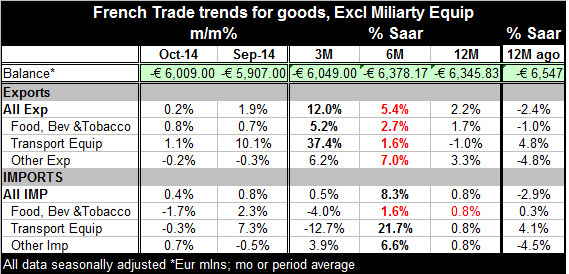 Global| Dec 09 2014
Global| Dec 09 2014French Imports Flounder While Exports Show Surprising Strength
Summary
France's trade deficit in October edged deeper into deficit falling to -6bln Euros from -5.9bln Euros. Both exports and imports edged higher in October but imports rose just slightly faster. That slightly faster speed plus the fact of [...]
 France's trade deficit in October edged deeper into deficit falling to -6bln Euros from -5.9bln Euros. Both exports and imports edged higher in October but imports rose just slightly faster. That slightly faster speed plus the fact of the trade position already being in deficit led to the slight widening in the deficit this month.
France's trade deficit in October edged deeper into deficit falling to -6bln Euros from -5.9bln Euros. Both exports and imports edged higher in October but imports rose just slightly faster. That slightly faster speed plus the fact of the trade position already being in deficit led to the slight widening in the deficit this month.
Underlying French export flows are showing some acceleration. Export growth steps up from 2.2% over 12-months to 5.4% over 6-months and to 12% over 3-months.
Import growth rates are no so robust. Imports grow at a 0.8% pace over 12-months and at a 0.5% pace over three months. In between they pop up to 8.3% over 6-months. There is no trend here, but there is more than a hint of still weak rates of growth.
By commodity classification French exports are mostly accelerating from 12-months to 6-months to 3-months. Transportation equipment exports are accelerating very sharply. Conversely, imports are decelerating on all fronts from 6-months to three-months. But none of the components show any clear trend since all are relatively stronger over six months compared to 12-months.
Still the 12-month and 3-month weakness in French imports are not in any way undone by the presence of 6-month strength The French domestic economy is weak on all counts and these import figures are more or less what we would expect to find with a weak economy. French export strength is surprising. One reason is that French military exports were up this month but apart from that there is still some life in exports. We do not see strength even in German exports and that should make us suspicious of French export acceleration.
French trade trends, without military goods, shows the opposite pattern with imports stronger and exports weaker (see chart). French trade trades raise more questions than they answer. But the import numbers are consistent with a still weak French economy. The export ramp up seems more likely to be an artifact of the data rather than a real trend when. We view it in the connection with other recent French reports there is not context for export strength. Moreover the French trade deficit tells a pretty consistent story of little change as its 12-month, 6-monthand 3-month averages are all so similar showing only a modest trend to smaller deficits. French exports are outpacing imports but a good deal of that is the consistent weakens of French imports.

Robert Brusca
AuthorMore in Author Profile »Robert A. Brusca is Chief Economist of Fact and Opinion Economics, a consulting firm he founded in Manhattan. He has been an economist on Wall Street for over 25 years. He has visited central banking and large institutional clients in over 30 countries in his career as an economist. Mr. Brusca was a Divisional Research Chief at the Federal Reserve Bank of NY (Chief of the International Financial markets Division), a Fed Watcher at Irving Trust and Chief Economist at Nikko Securities International. He is widely quoted and appears in various media. Mr. Brusca holds an MA and Ph.D. in economics from Michigan State University and a BA in Economics from the University of Michigan. His research pursues his strong interests in non aligned policy economics as well as international economics. FAO Economics’ research targets investors to assist them in making better investment decisions in stocks, bonds and in a variety of international assets. The company does not manage money and has no conflicts in giving economic advice.






